Tōkyū Den-en-toshi Line
| Tokyu Den-en-toshi Line | |
|---|---|
| DT | |
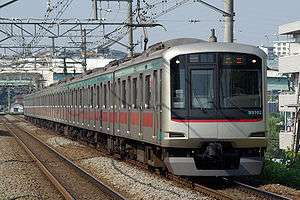 | |
| Overview | |
| Native name | 東急田園都市線 |
| Type | Commuter rail |
| Locale | Kantō Region |
| Termini |
Shibuya Chūō-Rinkan |
| Stations | 27 |
| Daily ridership | 1,162,282 (daily, 2010)[1] |
| Operation | |
| Opened | 11 October 1963 |
| Owner | Tokyu Corporation |
| Depot(s) | Nagatsuta |
| Technical | |
| Line length | 31.5 km (19.6 mi) |
| Track gauge | 1,067 mm (3 ft 6 in) |
| Electrification | 1,500 V DC overhead catenary |
| Route diagram | ||||||||||||||||||||||||||||||||||||||||||||||||||||||||||||||||||||||||||||||||||||||||||||||||||||||||||||||||||||||||||||||||||||||||||||||||||||||||||||||||||||||||||||||||||||||||||||||||||||||||||||||||||||||||||||||||||||||||||||||||||||||||||||||||||||||||||||||||||||||||||||||||||||||||||||||||||||||||||||||||||||||||||||||||||||||||||||||||||||||||||
|---|---|---|---|---|---|---|---|---|---|---|---|---|---|---|---|---|---|---|---|---|---|---|---|---|---|---|---|---|---|---|---|---|---|---|---|---|---|---|---|---|---|---|---|---|---|---|---|---|---|---|---|---|---|---|---|---|---|---|---|---|---|---|---|---|---|---|---|---|---|---|---|---|---|---|---|---|---|---|---|---|---|---|---|---|---|---|---|---|---|---|---|---|---|---|---|---|---|---|---|---|---|---|---|---|---|---|---|---|---|---|---|---|---|---|---|---|---|---|---|---|---|---|---|---|---|---|---|---|---|---|---|---|---|---|---|---|---|---|---|---|---|---|---|---|---|---|---|---|---|---|---|---|---|---|---|---|---|---|---|---|---|---|---|---|---|---|---|---|---|---|---|---|---|---|---|---|---|---|---|---|---|---|---|---|---|---|---|---|---|---|---|---|---|---|---|---|---|---|---|---|---|---|---|---|---|---|---|---|---|---|---|---|---|---|---|---|---|---|---|---|---|---|---|---|---|---|---|---|---|---|---|---|---|---|---|---|---|---|---|---|---|---|---|---|---|---|---|---|---|---|---|---|---|---|---|---|---|---|---|---|---|---|---|---|---|---|---|---|---|---|---|---|---|---|---|---|---|---|---|---|---|---|---|---|---|---|---|---|---|---|---|---|---|---|---|---|---|---|---|---|---|---|---|---|---|---|---|---|---|---|---|---|---|---|---|---|---|---|---|---|---|---|---|---|---|---|---|---|---|---|---|---|---|---|---|---|---|---|---|---|---|---|---|---|---|---|---|---|---|---|---|---|---|---|---|---|---|---|---|---|---|---|
| ||||||||||||||||||||||||||||||||||||||||||||||||||||||||||||||||||||||||||||||||||||||||||||||||||||||||||||||||||||||||||||||||||||||||||||||||||||||||||||||||||||||||||||||||||||||||||||||||||||||||||||||||||||||||||||||||||||||||||||||||||||||||||||||||||||||||||||||||||||||||||||||||||||||||||||||||||||||||||||||||||||||||||||||||||||||||||||||||||||||||||

The Tokyu Den-en-toshi Line (東急田園都市線 Tōkyū Den'entoshi-sen, "Tokyu Garden City Line") is a major commuter line operated by the private railway operator Tokyu Corporation and connecting south-western suburbs of Tokyo and neighbouring Kanagawa Prefecture, with its western terminus of Chūō-Rinkan, to a major railway junction of western downtown Tokyo, Shibuya. At Shibuya, nearly all the trains continue on the Tokyo Metro Hanzomon Line.
The line's color on maps and station guides is green, and stations carry the prefix "DT" followed by a number.
Operation
Nearly all trains on the Den-en-toshi Line are operated through to/from the Tokyo Metro Hanzomon Line using Tokyu, Tokyo Metro, and Tobu Railway 10-car EMUs. Around half of them continue beyond Oshiage, the terminus of the Hanzomon Line, to the Tobu Skytree Line (Kita-Koshigaya Station, Kita-Kasukabe Station and Tōbu-Dōbutsu-Kōen Station), Tobu Isesaki Line (Kuki Station), and Tōbu Nikkō Line (Minami-Kurihashi Station).
Service types
The following three types of service are operated on the line.
- Local (普通 Futsū) (L)
- Stop at all stations. Eight services per hour in each direction during the daytime.
- Semi-Express (準急 Junkyū) (SE)
- In up direction on weekday mornings only.
- Express (急行 Kyūkō) (Ex)
- Four trains per hour in each direction during the daytime.
Through trains to Oimachi Line
On weekends, two six-car express trains per days are operated to/from Ōimachi and Nagatsuta. Also, a few trains are operated through to/from the Tokyu Oimachi Line to utilize forwardings to/from Saginuma depot, up to Ōimachi in the mornings, and down to Saginuma in the late evenings. These formations are 7-car sets, unlike the 10-car trains normally used on the line. A few express trains in holidays also serve from Chūō-Rinkan in the mornings, down in the evenings.
Stations
▲ indicate stations where trains stop on weekends and public holidays only.
| No. | Name | Japanese | Distance (km) | L | SE | Ex | Transfers | Location | |
|---|---|---|---|---|---|---|---|---|---|
| ↑ Through-services to/from Z Tokyo Metro Hanzomon Line ↑ | |||||||||
| DT01 | Shibuya | 渋谷 | 0.0 | O | O | O |
|
Shibuya | Tokyo |
| DT02 | Ikejiri-Ōhashi | 池尻大橋 | 1.9 | O | O | | | Setagaya | ||
| DT03 | Sangen-Jaya | 三軒茶屋 | 3.3 | O | O | O | SG Tokyu Setagaya Line | ||
| DT04 | Komazawa-Daigaku | 駒沢大学 | 4.8 | O | O | | | |||
| DT05 | Sakura-shimmachi | 桜新町 | 6.3 | O | O | | | |||
| DT06 | Yōga | 用賀 | 7.6 | O | O | | | |||
| DT07 | Futako-Tamagawa | 二子玉川 | 9.4 | O | O | O | OM Tokyu Oimachi Line | ||
| DT08 | Futako-Shinchi | 二子新地 | 10.1 | O | ↑ | | | Takatsu-ku, Kawasaki | Kanagawa | |
| DT09 | Takatsu | 高津 | 10.7 | O | ↑ | | | |||
| DT10 | Mizonokuchi | 溝の口 | 11.4 | O | O | O |
| ||
| DT11 | Kajigaya | 梶が谷 | 12.2 | O | ↑ | | | |||
| DT12 | Miyazakidai | 宮崎台 | 13.7 | O | ↑ | | | Miyamae-ku, Kawasaki | ||
| DT13 | Miyamaedaira | 宮前平 | 14.7 | O | ↑ | | | |||
| DT14 | Saginuma | 鷺沼 | 15.7 | O | O | O | |||
| DT15 | Tama-Plaza | たまプラーザ | 17.1 | O | O | O | Aoba-ku, Yokohama | ||
| DT16 | Azamino | あざみ野 | 18.2 | O | O | O | ■ Yokohama Municipal Subway Blue Line | ||
| DT17 | Eda | 江田 | 19.3 | O | ↑ | | | |||
| DT18 | Ichigao | 市が尾 | 20.6 | O | ↑ | | | |||
| DT19 | Fujigaoka | 藤が丘 | 22.1 | O | ↑ | | | |||
| DT20 | Aobadai | 青葉台 | 23.1 | O | O | O | |||
| DT21 | Tana | 田奈 | 24.5 | O | ↑ | | | |||
| DT22 | Nagatsuta | 長津田 | 25.6 | O | O | O | Midori-ku, Yokohama | ||
| DT23 | Tsukushino | つくし野 | 26.8 | O | ↑ | | | Machida | Tokyo | |
| DT24 | Suzukakedai | すずかけ台 | 28.0 | O | ↑ | | | |||
| DT25 | Minami-Machida | 南町田 | 29.2 | O | O | ▲ | |||
| DT26 | Tsukimino | つきみ野 | 30.3 | O | ↑ | | | Yamato | Kanagawa | |
| DT27 | Chūō-Rinkan | 中央林間 | 31.5 | O | O | O | |||
Footnotes
- ↑ The transfer between the Hanzomon Line and the Ginza Line at Shibuya is an out-of-system transfer since they are separate stations. Due to the distance between the two stations, transfers between the two lines are announced at Omotesando.
Problem points
During the weekday morning and evening rush hours, there is an intense congestion in the Denentoshi line. The busiest interval during the morning rush is between Ikejiri-Ohashi station and Shibuya Station, and the average congestion rate of the busiest time period is 184% in 2016 (the average of the train passing between 7:50-8:50). This is the third highest number on a major private railway line in the metropolitan area next to the Tokyo Metro Tozai line and the Odakyu Odawara line. When the pressure resistance test of Panasonic's laptop PC "Let'snote" which is selling the height of the shock tolerance was done in the train line in the metropolitan area, it recorded the maximum of 100kg of the test in the countryside City lines,
It is said that this value has been determined as a load resistance performance. Especially during the heavy morning rush of congestion, Nagatsuta station-from Shibuya Station to 29 per hour (average 2 minutes to 5 seconds intervals) is doing a high-density operation, the train is congested from Saginuma station to Shibuya Station for this [slow driving] state,
The delay is chronically occurring. Many measures have been taken to eliminate congestion and delays, but there are also problems such as stations and facilities, and there has been no drastic elimination.
Equipment problem of rural city lines, for convenience of equipment, such as the effective length of the platform, it is not possible to add the vehicle beyond the 10-car train.
Therefore, in order to improve the signal system, since the hematopoietic has reached the limit, as a path to run the train of the same degree of length is operating at almost the shortest average of 2 minutes 5 seconds interval, but still crowded it has become fierce. The problem caused by Shibuya station Shibuya Station is located in the basement at more than 600,000 stations a day, and it takes time to get in and out of the house because many passengers concentrate on narrow stairs.
In addition, because the home is one side of the island type Home 2 line, I have to wait in front of the station without entering the next train until it is easy to fall into the state that can not be alternating "dumpling operation" before the train departs, it is the neck of the rural city line, such as the cause of chronic train delay. There is a voice that asks for the expansion of the home, but Tokyu also has examined the improvement work of three-sided three-line, it is very difficult, such as extension of the home width because it is an underground station, a large amount of structures may be necessary.
The ion cost has not yet materialized. The expansion of the Congestion control organization and issuance has reached its limit, and a large amount of business expense is necessary for the double row of the underground section, and the site securing is difficult. Although the total population of Japan has been declining since 2005, the population is expected to continue to grow to around 2025.
Bypass route The Oimachi line,
which was departing from the station of the station on July 11, 2009, was stretched to the mouth of the ditch station. Along with the express operation of the Oimachi line, the time required to connect to the station to other cities such as Jiyugaoka, Ookayama, and Oimachi is shortened. Especially in the Meguro line which is connected at Ookayama station, the express operation has been started from September 25, 2006, and the function as a bypass route to the large Oimachi line and Meguro line will be granted. By these, some of the passengers heading to the city during the morning rush to transfer from via the Denentoshi line to via Oimachi Line, Meguro line, it is expected to suppress congestion.
In addition, this double line is a double line by the direction of the town line and Oimachi line, both stations of Futako-Shinchi and Takatsu are set up only on the line of the Denentoshi line, and the large Oimachi line passes through both stations except for a part of the morning and four trains per hour during the day. On March 30, 2008, the Yokohama Municipal Subway Green Line opened. This creates a new route to the central Tokyo by using the Green Line and the Toyoko line and the Meguro line from Kohoku New Town, and is expected to transfer from the route which uses the old Yokohama Municipal Subway Blue Line and the Denentoshi line to a new route.
This is expected to curb the congestion of the rural city lines.
Connecting six-door and seat-storage vehicles
For details, see section 6-Door seat storage vehicles In order to reduce boarding time and to alleviate congestion, the city line had introduced a train that connected six-door seat storage vehicles from February 14, 2005 to May 2017. In the organization of a part of the 5000 system, connecting the six-door seat storage vehicle to 4.5-8 car crowded especially because there are stairs and escalators at Shibuya Station, had been devoted to the train of the most crowded time zone.
Local Express
operation From the revision of the timetable of April 5, 2007, 13 of the Express in the morning rush hour arrived at Shibuya Station at 8 a.m. I changed to "Local Express". This type is to stop at the station between the Chuorinkan station and the station in the same stop of the express in the soil holiday diamond, and between the station and Shibuya station. As a result, the time required between the train station and Shibuya station in this time period was 15 minutes from the Express 13 minutes and 17 minutes from each stop.
This revision was reported in some newspapers and television programs, and became a topic in the downgrading of the express train is the mainstay of the route. The conventional diamond, in order to withdraw the express at the Sakura Shin-machi station at the peak at each station, only express to Shibuya station from each station of the West station was a first-come diamond was organized.
Therefore, the passenger was concentrated on the express, causing the congestion rate of more than 200%, and it was a source of the delay by the expansion of the boarding season accompanying it. The type change from the express to the local local is aimed at abolition of the siding from the mouth of the ditch to Shibuya station, and the leveling of the congestion rate and the delay suppression by it. Tokyu has announced that the delay was reduced by about one minute from the same period in the previous year at normal times, except in the rainy season as of May, 2007.
Based on this result, the operation time zone of the local Express was increased by 10 minutes from March 28, 2008, the following year.
In the process of setting up a new type, the following ideas had been compared, but both were rejected for the following reasons.
The plan to drive each station only at the entire interval Chuorinkan-the required time between Shibuya is about 50 minutes, greatly impair the express.
Mouth of the ditch-at the time of arrival of the mouth of the proposal groove to establish the type to stop at each station between Shibuya, the rush rate is about 30% higher than the train stop, the congestion rate leveling can not be expected.
The plan to abolish the siding of the Sakura Shin-machi station unchanged leave the express Saginuma-the passenger of the express passing station between Shibuya concentrated on each station stop, there is a possibility that each station stop is crowded than the express. Also, when deciding the species alias, since the rapid and almost stop station that had been operating in the past is the same "fast" was also listed in the candidate of the type name. However, when both rapid and express had been driving in the past, and that there was an opinion that it is difficult to understand whether the express fast or fast, by the species that are already used in the direct-ahead Tobu Isesaki line (Tobu Sky tree line),
"Express" was adopted by the name that it is easy to distinguish between a simple and rapid (to be abolished in the timetable revision of April 21, 2017 to Tobu Sky Tree line), but, it becomes the upper type than express and local express unlike Tokyu Denentoshi line). The same measures are also being carried out between Nishi-Funabashi station-Toyocho station, which is a fast driving section of the Tokyo Metro Tozai line. In the morning rush hour train from Urayasu station to Toyocho station to stop in the "commuter fast" to unify, but is uniform congestion,
This is because each station stop is very crowded, and the reason is opposite to the rural city line.
In the busiest time zone is operated to be limited to the Tokyu 5000 system which is basically connecting the six-door car (described below), but other vehicles are also used before and after the most crowded time zone. Then, from the timetable revision of June 21, 2014, the local express was also to be driven in the time zone other than the morning rush.
Campaign for congestion mitigation Since 2009
there has been a campaign to support the early morning cheer for the rural city line in order to alleviate the rush hour congestion in the countryside. This campaign passes through the automatic ticket gate at the Pasmo that the participants registered by the specified time. It is that the discount award can be received when presenting it to the registered mobile phone at the designated store, and the setting time is before the most crowded time zone.
It promotes the use of the less crowded time zone before the morning rush. The first implementation took place from November 13 to 25, 2009, accepting registration from mobile phones, and was held from December 1 to 18. Participation was a lottery, and 5,000 winners participated. Because of the favorable popularity, the lottery system was removed from May 17 to June 11 in 2010, and it was changed to allow participation only in pre-registration. In addition, the contents of the award were also expanded. It was implemented in a similar format from 15 November to 10 December 2010. In fiscal 2011, as a result of the increase in the introduction of the summer time by the influence of the great East Japan earthquake and the rise of the daylight saving process, we expanded the target line to Tokyu Line, excluding children's national and Setagaya lines, It was changed to allow registration in the middle of the period and was implemented. Following this format, we have expanded the period from March 17 to December 31, 2012.
In 2013, it was implemented almost all year round from January 7 to December 31, and it was also compatible with Suica.
It was intended only on weekdays until 2010, but has also been covered since 2011. In 2017, congestion mitigation initiatives as "Goody Morning", from July 11 to August 31, among customers who pass through the Shibuya station on weekdays by 7:30 a.m., the app for smartphones "Tokyu line app" to customers who have installed " Coupon "(" Goody ") was delivered for the first time" good choice ", which means" better choice ".
Coupon types include discount vouchers for Lawson drinks and a discount coupon for the Tokyu Sports System Fitness Club.
Operation of the Special express train In conjunction with the Tokyo Metropolitan Congestion Mitigation project "Time Difference Biz", a special limited express train to Tokyo Metro Hanzomon line Chuorinkan from July 11, 2017 to 6:00 a.m. on Tuesday to Friday morning, the "Time Difference Biz Liner" was operated. It also runs in the summer of 2018.
Currently, measures such as transport capacity enhancement by the method such as the fly of the large Oimachi line has been made, it has become a multi-line portion of the ground with this double track portion.
Rolling stock
- Tokyu 2000 series
- Tokyu 2020 series[2]
- Tokyu 5000 series
- Tokyu 8500 series
- Tokyu 8590 series
- Tokyo Metro 8000 series
- Tokyo Metro 08 series
- Tobu 30000 series
- Tobu 50050 series
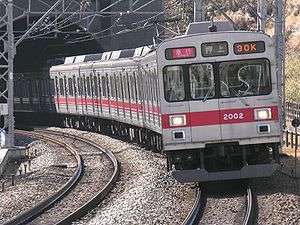 Tokyu 2000 series
Tokyu 2000 series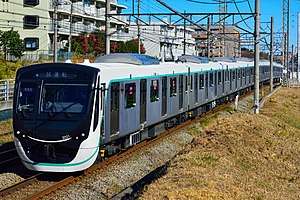 Tokyu 2020 series
Tokyu 2020 series Tokyu 5000 series
Tokyu 5000 series Tokyu 8500 series
Tokyu 8500 series Tokyu 8590 series
Tokyu 8590 series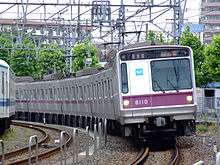 Tokyo Metro 8000 series
Tokyo Metro 8000 series Tokyo Metro 08 series
Tokyo Metro 08 series- Tobu 30000 series
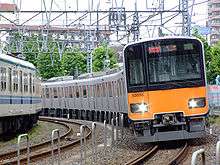 Tobu 50050 series
Tobu 50050 series
History
Prewar predecessors
On March 6, 1907, the Tamagawa Electric Railway (玉川電気鉄道 Tamagawa Denki Tetsudō, "Tamaden") opened the first section of the Tamagawa Line (玉川線) tramway (not to be confused with today's Tokyu Tamagawa Line) between Shibuya and what is now Futako-Tamagawa, using 1,372 mm (4 ft 6 in) gauge. The branch from Sangen-Jaya Station opened on January 18, 1925, and was split off into the present Tokyu Setagaya Line in 1969.
Tama Den-En-Toshi Plan
In 1953, Tokyu Group president Keita Gotō unveiled a "new town" planning scheme called the South-Western Area Development Plan. He envisioned new railway and freeway infrastructure (the latter being realized as the Tōmei Expressway) and large, clean houses for commuters working in Tokyo.
Development of the line
Through service was extended beyond Suitengūmae to Oshiage on March 19, 2003, allowing through service with the Isesaki Line and Nikkō Line of Tobu Railway.
Tokyu has expanded the line to four tracks from Futako-Tamagawa to Mizonokuchi; most trains of the Ōimachi line run through this section to Mizonokuchi, with some local trains making the intermediate stops. This service began on June 2009, postponed from fiscal 2007. Ōimachi line trains, which are 5- or 6-car sets, will then run between Ōimachi and Mizonokuchi.[3]
Future developments
Platform edge doors are scheduled to be installed at all stations on the line by 2020.[4]
References
- ↑ Tokyu ridership in 2010 Train Media (sourced from Tokyu) Retrieved May 28, 2012.
- ↑ 大井町線の急行運転 Archived 2008-03-22 at the Wayback Machine. accessed March 26, 2008
- ↑ 2020年を目標に東横線・田園都市線・大井町線の全64駅にホームドアを設置します [Platform edge doors to be installed at all 64 stations on Toyoko Line, Den-en-toshi Line, and Oimachi Line]. News release (in Japanese). Japan: Tokyu Corporation. 9 January 2015. Archived from the original on 2015-01-09. Retrieved 31 July 2015.
Coordinates: 35°31′55″N 139°29′40″E / 35.53194°N 139.49444°E